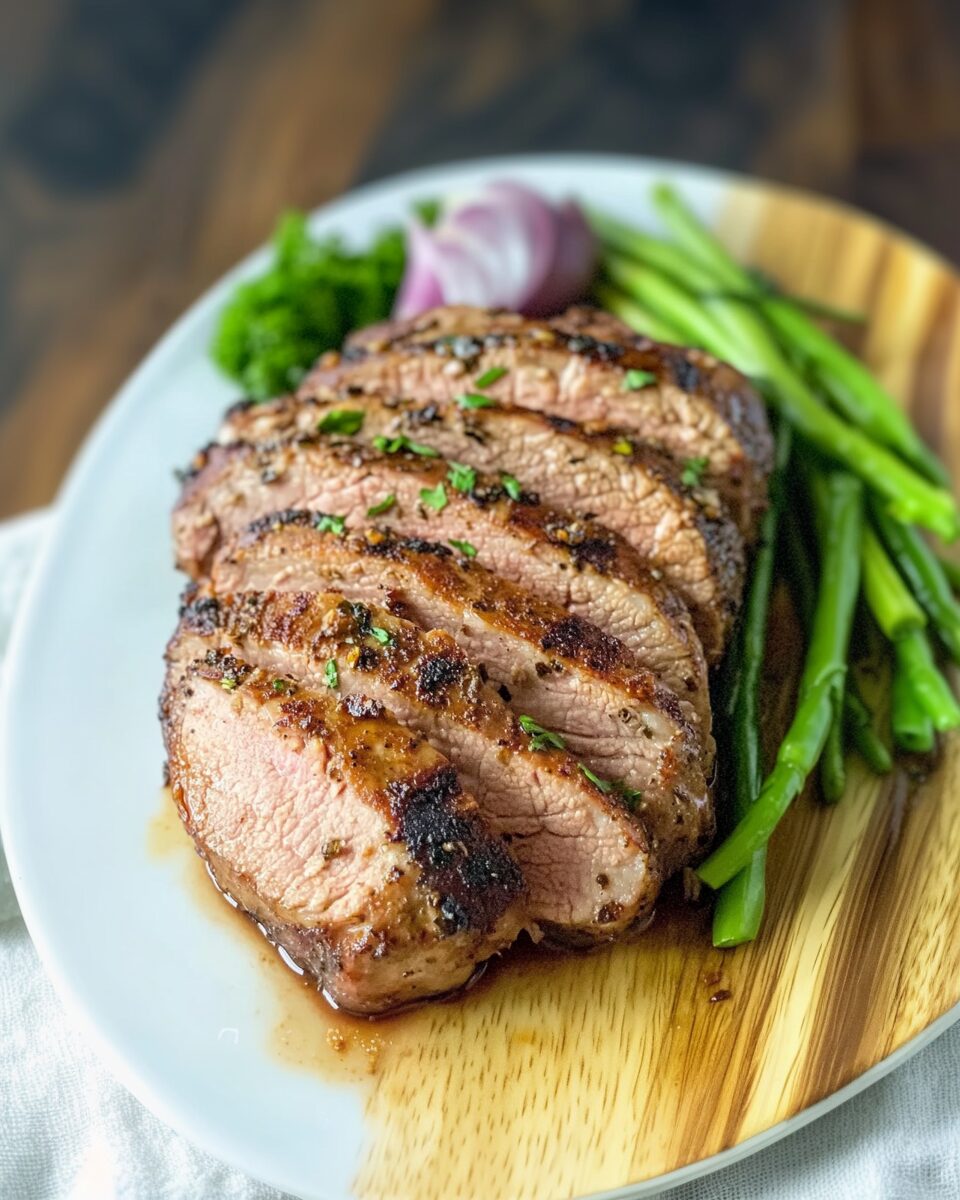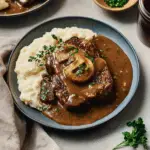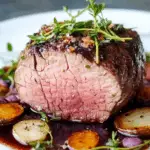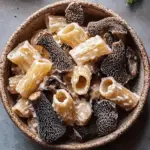This Roasted Pork Tenderloin is a quick and easy main course, perfect for weeknight dinners or special occasions. The tenderloin is seasoned with a flavorful dry rub, seared to create a beautiful crust, and then roasted to perfection. The result is juicy, tender meat that’s sure to impress.
Full Recipe:
Ingredients
- 1½ lb pork tenderloin
- 1 tsp sea salt, or to taste
- ½ tsp freshly ground black pepper
- 1 tsp Italian seasoning
- 1 tsp garlic powder
- 1 tsp ground coriander
- 2 Tbsp olive oil (extra light), or vegetable oil, or avocado oil
Directions
- Preheat oven to 400°F (200°C) with the rack positioned in the middle.
- Trim the tenderloin of fat and any silver skin, then pat dry with a paper towel.
- Pierce the pork tenderloin all over with a fork and rub with 1 tablespoon of oil.
- In a small bowl, combine sea salt, black pepper, Italian seasoning, garlic powder, and ground coriander.
- Sprinkle the dry rub onto the tenderloin and use your hands to rub the spices into the meat until evenly coated.
- Heat 1 tablespoon of oil over medium-high heat in a large oven-safe pan (cast iron or Dutch oven).
- Once the oil is hot, add the pork and brown on all sides, about 6 minutes total.
- Place the pan in the oven and bake uncovered at 400°F (200°C) for 13–15 minutes, flipping the tenderloin over halfway through baking.
- Bake until the center of the pork registers at least 150°F (65°C) on an instant-read thermometer.
- Transfer the pork to a cutting board and let it rest for 5–10 minutes.
- Slice into medallions and serve.
Nutrients
Per serving (1 serving, approximately 4 oz):
- Calories: 271
- Total Fat: 13g
- Saturated Fat: 3g
- Polyunsaturated Fat: 2g
- Monounsaturated Fat: 7g
- Trans Fat: 0.1g
- Cholesterol: 111mg
- Sodium: 671mg
- Potassium: 688mg
- Total Carbohydrates: 1g
- Dietary Fiber: 0.3g
- Sugars: 0.04g
- Protein: 35g
- Vitamin A: 15 IU
- Vitamin C: 0.2mg
- Calcium: 21mg
- Iron: 2mg
Why Roasted Pork Tenderloin?
Pork tenderloin is an incredibly versatile cut of meat, offering numerous cooking possibilities. Its mild flavor makes it a perfect canvas for various seasonings, marinades, and cooking methods. Roasting pork tenderloin helps to preserve its natural juices while creating a beautifully browned, flavorful crust on the outside. This method enhances the meat’s tenderness, resulting in a juicy interior that melts in your mouth with every bite.
One of the best things about roasted pork tenderloin is its quick cooking time. Unlike other cuts of pork that require slow roasting or braising, pork tenderloin cooks relatively quickly, making it an excellent option for busy weeknights. You can have a flavorful, hearty meal ready in just under an hour.
Choosing the Right Pork Tenderloin
When preparing this recipe, selecting the right pork tenderloin is crucial to ensuring a successful dish. Look for a tenderloin that is lean, with minimal fat and no visible silverskin (a tough connective tissue that should be removed before cooking). The tenderloin should be firm and smooth in texture, with a pale pink color. If you have the option, opt for a high-quality, sustainably sourced pork tenderloin, as this will make a noticeable difference in flavor.
Seasoning and Flavor Combinations
The beauty of roasted pork tenderloin lies in its versatility when it comes to seasoning. This particular recipe uses a blend of simple yet effective seasonings, including sea salt, black pepper, garlic powder, Italian seasoning, and ground coriander. These spices create a fragrant and savory flavor profile that complements the pork’s natural taste without overpowering it.
Italian seasoning is an herbaceous blend typically consisting of basil, oregano, thyme, and rosemary. This combination of herbs is perfect for enhancing the pork’s flavor, adding both earthy and aromatic notes. Garlic powder provides a subtle depth of flavor, while ground coriander brings a touch of citrusy brightness, balancing the richness of the meat.
For those looking to experiment with other flavors, there are endless possibilities. Adding smoked paprika can lend a mild smokiness, while a splash of balsamic vinegar can bring a tangy sweetness. You can also create a sweet and savory profile by adding brown sugar, mustard, or honey to the rub, or marinating the tenderloin in a flavorful mixture.
The Importance of Searing
Searing the pork tenderloin before roasting it is a critical step that should not be skipped. Searing creates a beautiful brown crust on the outside of the meat, locking in its juices and enhancing the overall flavor. The Maillard reaction, which occurs when proteins and sugars in the meat react to high heat, is responsible for this crispy, flavorful outer layer.
To achieve a perfect sear, heat your pan over medium-high heat before adding oil. Once the oil is hot, carefully place the pork tenderloin in the pan and allow it to brown on all sides, usually about 2–3 minutes per side. It’s essential to let the pork rest on each side for a full sear to maximize the flavor and texture.
Roasting and Cooking Time
Roasting the pork tenderloin is a straightforward process, but it’s important to keep an eye on the cooking time to avoid overcooking. Pork tenderloin is best cooked to an internal temperature of 145°F (63°C), which ensures the meat remains juicy and slightly pink in the center. Overcooking the pork will result in a dry, tough texture, so it’s essential to use an instant-read thermometer to check the temperature during the roasting process.
The cooking time may vary depending on the size of the tenderloin and your oven, but generally, roasting the pork at 400°F (200°C) for 13–15 minutes will yield a perfectly cooked tenderloin. It’s also crucial to let the meat rest for about 5–10 minutes after removing it from the oven. This resting period allows the juices to redistribute, ensuring a moist and tender result.
Serving Suggestions
Once the pork tenderloin is roasted to perfection, it can be sliced into medallions and served with a variety of side dishes. Roasted vegetables such as carrots, Brussels sprouts, and potatoes are excellent accompaniments that complement the savory flavors of the pork. A simple green salad with a tangy vinaigrette can provide a refreshing contrast to the richness of the meat.
For a more indulgent meal, serve the pork with mashed potatoes or a creamy risotto. The tender, juicy pork pairs wonderfully with these hearty sides, creating a well-rounded, satisfying meal. If you prefer a lighter option, steamed vegetables or a grain salad, such as quinoa or couscous, can balance out the richness of the pork.
Storage and Leftovers
If you have any leftover pork tenderloin, it can be stored in the refrigerator for up to 3–4 days. Simply wrap it tightly in plastic wrap or aluminum foil to preserve its freshness. Leftover pork tenderloin can be used in a variety of dishes, such as sandwiches, salads, or tacos. You can also slice the leftovers and reheat them in a skillet with a bit of oil to restore their juiciness.
For longer storage, you can freeze cooked pork tenderloin. Wrap the meat in plastic wrap and aluminum foil before placing it in an airtight container or freezer bag. Frozen pork tenderloin will maintain its quality for up to 2–3 months. When ready to enjoy, thaw it overnight in the refrigerator and reheat it using your preferred method.
Health Benefits of Pork Tenderloin
Pork tenderloin is not only delicious but also a healthy choice for those looking to incorporate lean protein into their diet. Compared to other cuts of pork, such as pork belly or shoulder, tenderloin is significantly lower in fat and calories. It’s an excellent source of high-quality protein, which is essential for muscle repair and overall health.
Conclusion
Roasted pork tenderloin is an easy-to-make yet impressive dish that can elevate any meal. Whether you’re cooking for a weeknight family dinner or preparing a special meal for guests, this dish offers a perfect balance of flavors and textures. With its tender, juicy meat and beautifully crisped crust, roasted pork tenderloin is sure to become a staple in your cooking repertoire. By experimenting with different seasoning blends and side dishes, you can create a variety of meals that suit your personal tastes and dietary preferences.






